扩大减压的经椎间孔椎间融合术治疗下腰椎疾病的疗效分析
- 格式:pdf
- 大小:276.25 KB
- 文档页数:4
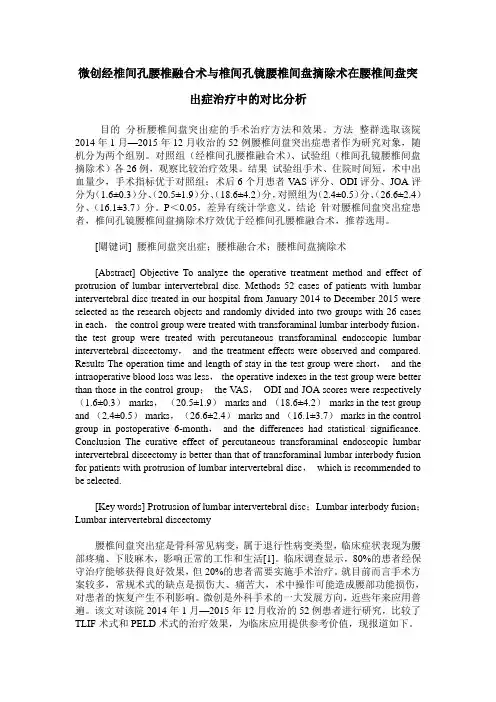
微创经椎间孔腰椎融合术与椎间孔镜腰椎间盘摘除术在腰椎间盘突出症治疗中的对比分析目的分析腰椎间盘突出症的手术治疗方法和效果。
方法整群选取该院2014年1月—2015年12月收治的52例腰椎间盘突出症患者作为研究对象,随机分为两个组别。
对照组(经椎间孔腰椎融合术)、试验组(椎间孔镜腰椎间盘摘除术)各26例,观察比较治疗效果。
结果试验组手术、住院时间短,术中出血量少,手术指标优于对照组;术后6个月患者V AS评分、ODI评分、JOA评分为(1.6±0.3)分、(20.5±1.9)分、(18.6±4.2)分,对照组为(2.4±0.5)分、(26.6±2.4)分、(16.1±3.7)分。
P<0.05,差异有统计学意义。
结论针对腰椎间盘突出症患者,椎间孔镜腰椎间盘摘除术疗效优于经椎间孔腰椎融合术,推荐选用。
[關键词] 腰椎间盘突出症;腰椎融合术;腰椎间盘摘除术[Abstract] Objective To analyze the operative treatment method and effect of protrusion of lumbar intervertebral disc. Methods 52 cases of patients with lumbar intervertebral disc treated in our hospital from January 2014 to December 2015 were selected as the research objects and randomly divided into two groups with 26 cases in each,the control group were treated with transforaminal lumbar interbody fusion,the test group were treated with percutaneous transforaminal endoscopic lumbar intervertebral discectomy,and the treatment effects were observed and compared. Results The operation time and length of stay in the test group were short,and the intraoperative blood loss was less,the operative indexes in the test group were better than those in the control group;the V AS,ODI and JOA scores were respectively (1.6±0.3)marks,(20.5±1.9)marks and (18.6±4.2)marks in the test group and (2.4±0.5)marks,(26.6±2.4)marks and (16.1±3.7)marks in the control group in postoperative 6-month,and the differences had statistical significance. Conclusion The curative effect of percutaneous transforaminal endoscopic lumbar intervertebral discectomy is better than that of transforaminal lumbar interbody fusion for patients with protrusion of lumbar intervertebral disc,which is recommended to be selected.[Key words] Protrusion of lumbar intervertebral disc;Lumbar interbody fusion;Lumbar intervertebral discectomy腰椎间盘突出症是骨科常见病变,属于退行性病变类型,临床症状表现为腰部疼痛、下肢麻木,影响正常的工作和生活[1]。

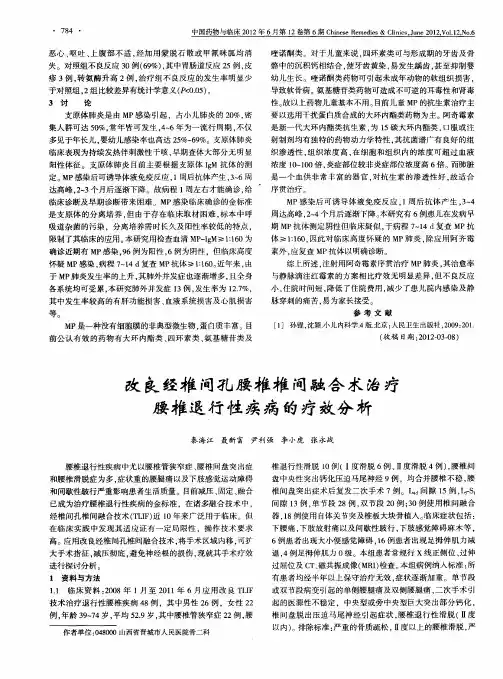
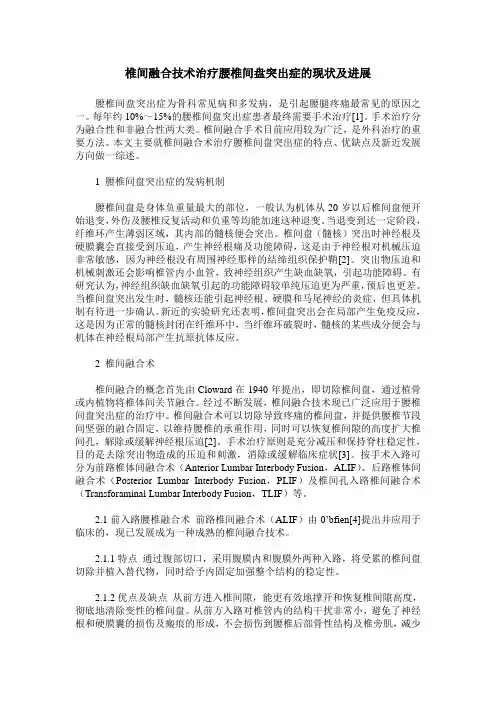
椎间融合技术治疗腰椎间盘突出症的现状及进展腰椎间盘突出症为骨科常见病和多发病,是引起腰腿疼痛最常见的原因之一。
每年约10%~15%的腰椎间盘突出症患者最终需要手术治疗[1]。
手术治疗分为融合性和非融合性两大类。
椎间融合手术目前应用较为广泛,是外科治疗的重要方法。
本文主要就椎间融合术治疗腰椎间盘突出症的特点、优缺点及新近发展方向做一综述。
1 腰椎间盘突出症的发病机制腰椎间盘是身体负重量最大的部位,一般认为机体从20岁以后椎间盘便开始退变,外伤及腰椎反复活动和负重等均能加速这种退变。
当退变到达一定阶段,纤维环产生薄弱区域,其内部的髓核便会突出。
椎间盘(髓核)突出时神经根及硬膜囊会直接受到压迫,产生神经根痛及功能障碍,这是由于神经根对机械压迫非常敏感,因为神经根没有周围神经那样的结缔组织保护鞘[2]。
突出物压迫和机械刺激还会影响椎管内小血管,致神经组织产生缺血缺氧,引起功能障碍。
有研究认为,神经组织缺血缺氧引起的功能障碍较单纯压迫更为严重,预后也更差。
当椎间盘突出发生时,髓核还能引起神经根、硬膜和马尾神经的炎症,但具体机制有待进一步确认。
新近的实验研究还表明,椎间盘突出会在局部产生免疫反应,这是因为正常的髓核封闭在纤维环中,当纤维环破裂时,髓核的某些成分便会与机体在神经根局部产生抗原抗体反应。
2 椎间融合术椎间融合的概念首先由Cloward在1940年提出,即切除椎间盘,通过植骨或内植物将椎体间关节融合。
经过不断发展,椎间融合技术现已广泛应用于腰椎间盘突出症的治疗中。
椎间融合术可以切除导致疼痛的椎间盘,并提供腰椎节段间坚强的融合固定,以维持腰椎的承重作用,同时可以恢复椎间隙的高度扩大椎间孔,解除或缓解神经根压迫[2]。
手术治疗原则是充分减压和保持脊柱稳定性,目的是去除突出物造成的压迫和刺激,消除或缓解临床症状[3]。
按手术入路可分为前路椎体间融合术(Anterior Lumbar Interbody Fusion,ALIF)、后路椎体间融合术(Posterior Lumbar Interbody Fusion,PLIF)及椎间孔入路椎间融合术(Transforaminal Lumbar Interbody Fusion,TLIF)等。
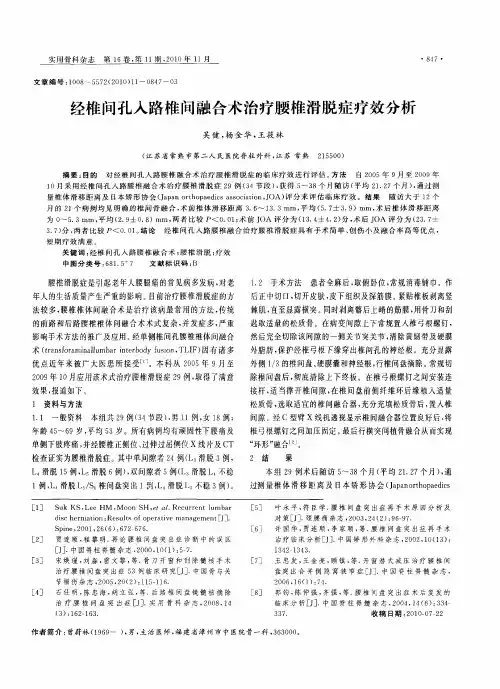
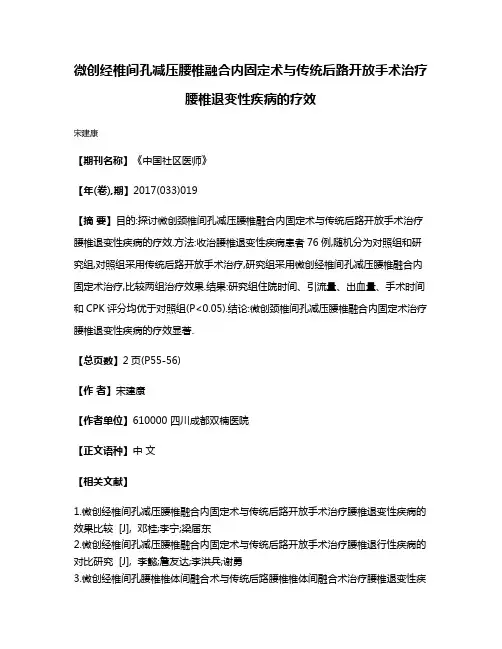
微创经椎间孔减压腰椎融合内固定术与传统后路开放手术治疗
腰椎退变性疾病的疗效
宋建康
【期刊名称】《中国社区医师》
【年(卷),期】2017(033)019
【摘要】目的:探讨微创颈椎间孔减压腰椎融合内固定术与传统后路开放手术治疗腰椎退变性疾病的疗效.方法:收治腰椎退变性疾病患者76例,随机分为对照组和研究组,对照组采用传统后路开放手术治疗,研究组采用微创经椎间孔减压腰椎融合内固定术治疗,比较两组治疗效果.结果:研究组住院时间、引流量、出血量、手术时间和CPK评分均优于对照组(P<0.05).结论:微创颈椎间孔减压腰椎融合内固定术治疗腰椎退变性疾病的疗效显著.
【总页数】2页(P55-56)
【作者】宋建康
【作者单位】610000 四川成都双楠医院
【正文语种】中文
【相关文献】
1.微创经椎间孔减压腰椎融合内固定术与传统后路开放手术治疗腰椎退变性疾病的效果比较 [J], 邓桂;李宁;梁届东
2.微创经椎间孔减压腰椎融合内固定术与传统后路开放手术治疗腰椎退行性疾病的对比研究 [J], 李懿;詹友达;李洪兵;谢勇
3.微创经椎间孔腰椎椎体间融合术与传统后路腰椎椎体间融合术治疗腰椎退变性疾
病的疗效及并发症比较 [J], 冯建宏;辛欣
4.微创经椎间孔腰椎融合内固定术与传统后路开放手术治疗腰椎退行性疾病的比较研究 [J], 蔡奋忠
5.微创经椎间孔减压腰椎融合内固定术与传统后路开放手术治疗腰椎退变性疾病的临床对比分析 [J], 徐新华
因版权原因,仅展示原文概要,查看原文内容请购买。
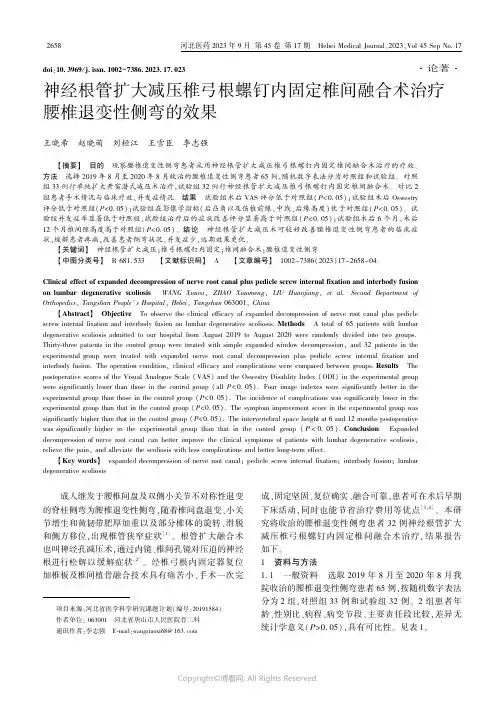
doi :10.3969/j.issn.1002-7386.2023.17.023·论著·神经根管扩大减压椎弓根螺钉内固定椎间融合术治疗腰椎退变性侧弯的效果王晓希 赵晓萌 刘桓江 王雪臣 李志强项目来源:河北省医学科学研究课题计划(编号:20191584)作者单位:063001 河北省唐山市人民医院骨二科通讯作者:李志强 E⁃mail:wangxiaoxi68@ 【摘要】 目的 观察腰椎退变性侧弯患者采用神经根管扩大减压椎弓根螺钉内固定椎间融合术治疗的疗效。
方法 选择2019年8月至2020年8月收治的腰椎退变性侧弯患者65例,随机数字表法分为对照组和试验组。
对照组33例行单纯扩大开窗潜式减压术治疗,试验组32例行神经根管扩大减压椎弓根螺钉内固定椎间融合术。
对比2组患者手术情况与临床疗效、并发症情况。
结果 试验组术后VAS 评分低于对照组(P <0.05);试验组术后Oswestry 评分低于对照组(P <0.05);试验组在影像学指标(后凸角以及伤椎前缘、中线、后缘高度)优于对照组(P <0.05)。
试验组并发症率显著低于对照组,试验组治疗后的症状改善评分显著高于对照组(P <0.05);试验组术后6个月、术后12个月椎间隙高度高于对照组(P <0.05)。
结论 神经根管扩大减压术可较好改善腰椎退变性侧弯患者的临床症状,缓解患者疼痛,改善患者侧弯状况,并发症少,远期效果更优。
【关键词】 神经根管扩大减压;椎弓根螺钉内固定;椎间融合术;腰椎退变性侧弯【中图分类号】 R 681.533 【文献标识码】 A 【文章编号】 1002-7386(2023)17-2658-04Clinical effect of expanded decompression of nerve root canal plus pedicle screw internal fixation and interbody fusion on lumbar degenerative scoliosis WANG Xiaoxi ,ZHAO Xiaomeng ,LIU Huanjiang ,et al.Second Department of Orthopedics ,Tangshan People ’s Hospital ,Hebei ,Tangshan 063001,China【Abstract 】 Objective To observe the clinical efficacy of expanded decompression of nerve root canal plus pedicle screw internal fixation and interbody fusion on lumbar degenerative scoliosis.Methods A total of 65patients with lumbar degenerative scoliosis admitted to our hospital from August 2019to August 2020were randomly divided into two groups.Thirty⁃three patients in the control group were treated with simple expanded window decompression ,and 32patients in the experimental group were treated with expanded nerve root canal decompression plus pedicle screw internal fixation and interbody fusion.The operation condition ,clinical efficacy and complications were compared between groups.Results The postoperative scores of the Visual Analogue Scale (VAS )and the Oswestry Disablity Index (ODI )in the experimental group were significantly lower than those in the control group (all P <0.05).Four image indexes were significantly better in the experimental group than those in the control group (P <0.05).The incidence of complications was significantly lower in the experimental group than that in the control group (P <0.05).The symptom improvement score in the experimental group was significantly higher than that in the control group (P <0.05).The intervertebral space height at 6and 12months postoperative was significantly higher in the experimental group than that in the control group (P <0.05).Conclusion Expanded decompression of nerve root canal can better improve the clinical symptoms of patients with lumbar degenerative scoliosis ,relieve the pain ,and alleviate the scoliosis with less complications and better long⁃term effect.【Key words 】 expanded decompression of nerve root canal ;pedicle screw internal fixation ;interbody fusion ;lumbar degenerative scoliosis 成人继发于腰椎间盘及双侧小关节不对称性退变的脊柱侧弯为腰椎退变性侧弯,随着椎间盘退变、小关节增生和黄韧带肥厚加重以及部分椎体的旋转、滑脱和侧方移位,出现椎管狭窄症状[1]。
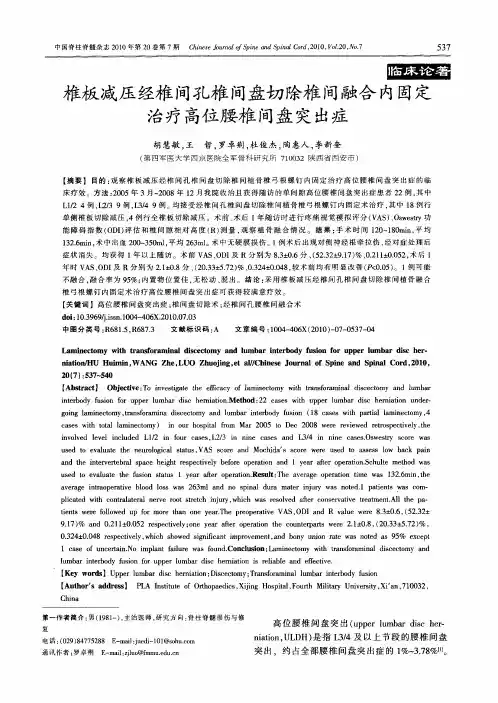
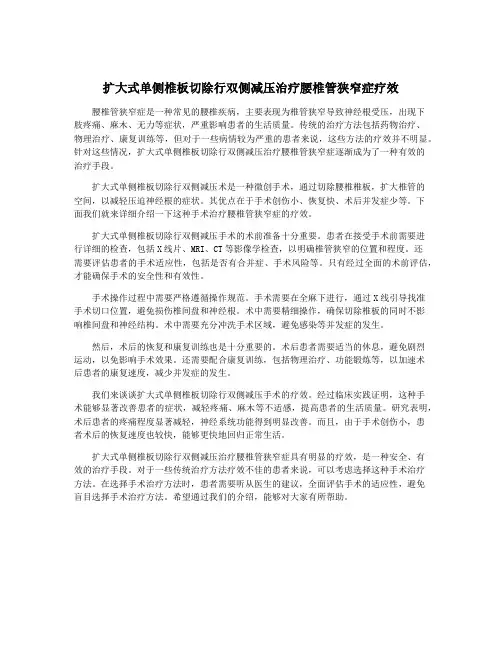
扩大式单侧椎板切除行双侧减压治疗腰椎管狭窄症疗效腰椎管狭窄症是一种常见的腰椎疾病,主要表现为椎管狭窄导致神经根受压,出现下肢疼痛、麻木、无力等症状,严重影响患者的生活质量。
传统的治疗方法包括药物治疗、物理治疗、康复训练等,但对于一些病情较为严重的患者来说,这些方法的疗效并不明显。
针对这些情况,扩大式单侧椎板切除行双侧减压治疗腰椎管狭窄症逐渐成为了一种有效的治疗手段。
扩大式单侧椎板切除行双侧减压术是一种微创手术,通过切除腰椎椎板,扩大椎管的空间,以减轻压迫神经根的症状。
其优点在于手术创伤小、恢复快、术后并发症少等。
下面我们就来详细介绍一下这种手术治疗腰椎管狭窄症的疗效。
扩大式单侧椎板切除行双侧减压手术的术前准备十分重要。
患者在接受手术前需要进行详细的检查,包括X线片、MRI、CT等影像学检查,以明确椎管狭窄的位置和程度。
还需要评估患者的手术适应性,包括是否有合并症、手术风险等。
只有经过全面的术前评估,才能确保手术的安全性和有效性。
手术操作过程中需要严格遵循操作规范。
手术需要在全麻下进行,通过X线引导找准手术切口位置,避免损伤椎间盘和神经根。
术中需要精细操作,确保切除椎板的同时不影响椎间盘和神经结构。
术中需要充分冲洗手术区域,避免感染等并发症的发生。
然后,术后的恢复和康复训练也是十分重要的。
术后患者需要适当的休息,避免剧烈运动,以免影响手术效果。
还需要配合康复训练,包括物理治疗、功能锻炼等,以加速术后患者的康复速度,减少并发症的发生。
我们来谈谈扩大式单侧椎板切除行双侧减压手术的疗效。
经过临床实践证明,这种手术能够显著改善患者的症状,减轻疼痛、麻木等不适感,提高患者的生活质量。
研究表明,术后患者的疼痛程度显著减轻,神经系统功能得到明显改善。
而且,由于手术创伤小,患者术后的恢复速度也较快,能够更快地回归正常生活。
扩大式单侧椎板切除行双侧减压治疗腰椎管狭窄症具有明显的疗效,是一种安全、有效的治疗手段。
对于一些传统治疗方法疗效不佳的患者来说,可以考虑选择这种手术治疗方法。
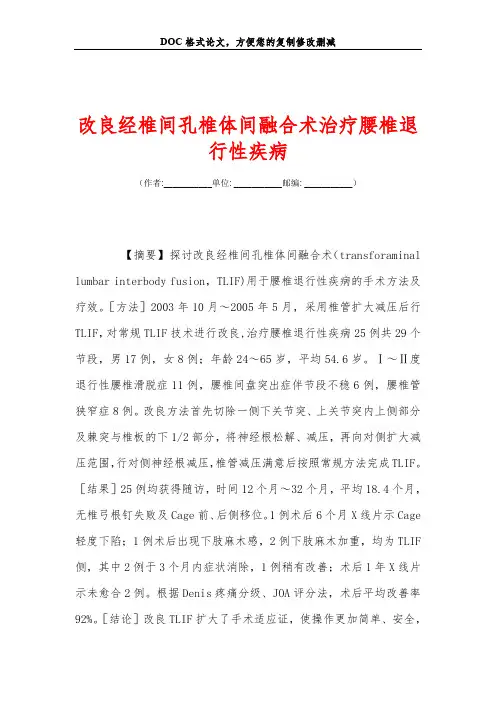
改良经椎间孔椎体间融合术治疗腰椎退行性疾病(作者:___________单位: ___________邮编: ___________)【摘要】探讨改良经椎间孔椎体间融合术(transforaminal lumbar interbody fusion,TLIF)用于腰椎退行性疾病的手术方法及疗效。
[方法]2003年10月~2005年5月,采用椎管扩大减压后行TLIF,对常规TLIF技术进行改良,治疗腰椎退行性疾病25例共29个节段,男17例,女8例;年龄24~65岁,平均54.6岁。
Ⅰ~Ⅱ度退行性腰椎滑脱症11例,腰椎间盘突出症伴节段不稳6例,腰椎管狭窄症8例。
改良方法首先切除一侧下关节突、上关节突内上侧部分及棘突与椎板的下1/2部分,将神经根松解、减压,再向对侧扩大减压范围,行对侧神经根减压,椎管减压满意后按照常规方法完成TLIF。
[结果]25例均获得随访,时间12个月~32个月,平均18.4个月,无椎弓根钉失败及Cage前、后侧移位。
1例术后6个月X线片示Cage 轻度下陷;1例术后出现下肢麻木感,2例下肢麻木加重,均为TLIF 侧,其中2例于3个月内症状消除,1例稍有改善;术后1年X线片示未愈合2例。
根据Denis疼痛分级、JOA评分法,术后平均改善率92%。
[结论]改良TLIF扩大了手术适应证,使操作更加简单、安全,并发症减少,选择性用于腰椎退行性疾病的短期疗效满意。
【关键词】腰椎退行性疾病脊柱融合术改良减压Abstract: [Objective]To explore the clinical application and result of modified transforaminal lumbar interbody fusion (TLIF) for the treatmentof lumbar degenerative disease. [Method] From October 2003 to May 2005, 25 patients(29 levels) suffering from lumbar degenerative disease were treated with modified TLIF. The modification included expansile decompression of vertebral canal combination with TLIF and pedicle screw instrumentation. There were 17 males and 8 females with average age of 54.6 years, ranging from 24 to 65 years. The preoperative diagnosis included lumbar degenerative spondylolisthesis (11 cases, GradeⅠtoⅡ),lumbar intervertebral disc protrusion combined with segmental instability (6 cases ) and lumbar spinal stenosis ( 8 cases). Expansile decompression of vertebral canal was applied as follows:total inferior facet process and inner half superior facet process of the trouble side were resected firstly,the compression for the nerve root caused by degenerative articular process and lateral recess stenosis was relieved. Then half spinous process and lamina were resected while decompression of the vertebral canal was expanded to opposite side until thenever root was decompressed satisfactorily. Care must be taken to avoid over resecting which lead to isthmic breaking. In the end, TLIF was performed according to normal procedure after the decompression of vertebral canal being accomplished. [Result]The lateral, AP, flexion-extension X-ray films were taken at 3, 6 months and 1 year after operation to evaluate the fusion, Simmons method and Denis pain measurement and JOA scoring were adopted to determine the results. The intraoperative blood loss ranged from 310 to 820ml (mean, 530ml), and total operative time ranged from 110 to 210min (mean, 165min). Blood transfusion was carried out in 6 patients (range, 400 to 800 ml). All patients were followed up for 12 to 36 months (mean, 18.4 months), no failure of pedicle screws and cage migration occurred .One cage subsidence and 2 nonunion were shown in plain X-ray films,3 patients complained of worsening numbness in legs in side which TLIF was performed. The rate of improvement was 92% in all patients according to above evaluation methods. [Conclusion]The modified TLIF expands the indications for TLIF. Operative procedure can be performed more easily and safely with less complications. The clinical results are satisfactory in some selected patients suffering from lumbar degenerative disease according to the author’s experience.Key words:lumbar vertebrae; degenerative disease; spinal fusion; modified; decompression对部分腰椎退行性疾病选择性地采用椎体间融合术治疗,疗效已经得到肯定,但以往主要采用后路腰椎体间融合术(posterior lumbar interbody fusion, PLIF),手术创伤较大,硬膜囊和神经根牵拉导致术中及术后并发症更是影响其疗效的重要原因[1~3]。
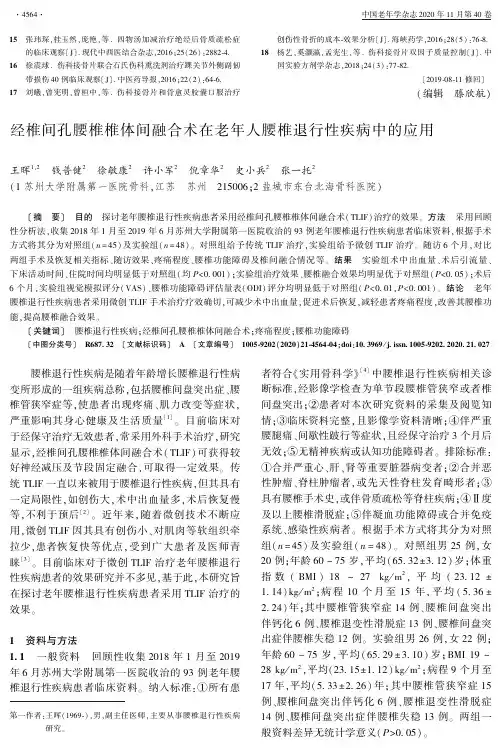
通过手术方式治疗腰椎退行性疾病的方法中,以腰椎融合运用最为广泛。
其中对于腰椎退行性疾病伴有节段明显失稳的患者,腰椎融合术已成为其治疗首选[1,2]。
腰椎融合术根据手术入路、植骨融合位置、减压内固定置入的不同可分为多种术式类别,而各类术式的适应症、禁忌症和优缺点不尽相同。
现对各类腰椎融合术式在腰椎退行性疾病运用上的研究进展作以下报道。
1腰椎椎间融合术(lumbar interbody fusion )腰椎椎间融合术是在摘除椎间盘后,通过植骨或内置物使椎体间相融合。
该术式最早用于椎体结核的治疗,1953年Cloward 首次将其用于下腰痛的治疗,取得了满意的疗效。
腰椎间融合根据作者单位:川北医学院附属遂宁市中医院骨科,四川遂宁629000*通讯作者:陈泽,Email :****************不同腰椎融合术式治疗腰椎退行性疾病的研究进展李笑峰,蒋曼,陈泽*,熊福生[摘要]腰椎退行性疾病是由椎间盘退变、椎间小关节增生紊乱、腰椎韧带松弛以及肌肉劳损等原因相互作用引起的以腰椎自然退化为特征的临床常见病。
近年来随着生活水平的提高,老龄化进程的加剧,腰椎退行性疾病在临床上的发病率也越来越高,给众多老年人的生活质量和身体健康带来严重的影响。
腰椎融合手术是治疗腰椎退行性疾病的重要手段,临床上腰椎融合术式种类多样,而各类术式有其自身适应症、禁忌症以及优缺点,各家研究报道结果不一,使得临床医师在不同术式的选择上一直存在争议,难以达成共识。
现就临床上各类腰椎融合术式治疗腰椎退行性疾病的研究现状进行综述。
[关键词]腰椎退行性疾病;腰椎融合术;综述doi :10.3969/j.issn.1009⁃976X.2021.02.025中图分类号:R681.5文献标识码:AResearch progress of different lumbar fusion methods in the treatment of lumbar degenerative diseasesLI Xiao⁃feng ,JIANG Man ,CHEN Ze ,XIONG Fu⁃shengDepartment of Orthopedics ,Suining Hospital of Traditional Chinese Medicine Affiliated to North Sichuan Medical College ,Suining ,Sichuan 629000,China Coresponding author :CHEN Ze ,****************[Abstract ]Lumbar degenerative disease is a common disease ,caused by intervertebral disc degenera⁃tion ,intervertebral facet hyperplasia and disorder ,lumbar ligament relaxation ,and muscle strain ,which is characterized by lumbar natural degeneration.In recent years ,with the improvement of living standardsand the intensification of the aging process ,the clinical incidence of lumbar degenerative diseases is getting higher and higher ,which has a serious impact on the quality of life and health of many elderly people.Lumbar fusion surgery is an important method for the treatment of lumbar degenerative diseases.Although there are various types of lumbar fusion in clinic ,each type of lumbar fusion has its own indica⁃tions ,contraindications ,advantages and disadvantages ,and the results of different studies are different.As a result ,clinicians have been controversial on the choice of different surgical methods ,and it is diffi⁃cult to reach a consensus.In this paper ,the present situation of clinical research on all kinds of lumbar fusion is reported as follows.[Key word ]lumbar degenerative disease ;lumbar fusion ;review手术入路可以分为经前路椎间融合术(anterior lumbar interbody fusion,ALIF)、经后路椎间融合术(posterior lumbar interbody fusion,PLIF)、经椎间孔椎间融合术(transforaminallumbar interbody fusion,TLIF)、斜外侧腰椎间融合术(oblique lumbar inter⁃body fusion,OLIF)、极外侧腰椎间融合术(extreme lateral lumbar interbody fusion,XLIF)。
中国修复重建外科杂志2008年4月第22卷第4期·501·时,操作要轻柔仔细,用神经剥离器分离后纵韧带和硬膜,防止脊髓和硬脊膜损伤,尤其是后纵韧带与硬脊膜有粘连者;③切除骨赘时,注意不要加重神经损伤;④切除部分钩椎关节时,最好直视神经根,以防神经根和椎动脉损伤。
本组未出现与减压有关的损伤。
3.5 扩大性椎管减压术的临床疗效 减压目的在于恢复神经功能,扩大性椎管减压术,一方面彻底减除了对神经的直接压迫,另一方面扩大了椎管矢状径和容积,恢复了颈椎的生理弧度、椎体高度和椎间高度,两者结合为神经功能恢复创造了充分条件,用于治疗脊髓型颈椎病取得了满意的临床疗效,是治疗脊髓型颈椎病的一种有效方法。
4 参考文献1 Boyce RH, Wang JC. Evaluation of neck pain, radiculopathy, and my-elopathy: imaging, conservative treatment, and surgical indications.Instr Coupe Lect, 2003, 52(3): 489-495.2 陈锋. 脊髓型颈椎病脊髓微血管神经元微环境改变实验研究. 中国矫形外科杂志, 2004, 12(13): 1009-1010. 3 张威江, 汪桦. MRI运动扫描分析脊髓型颈椎病的脊髓致压因素. 中华放射学杂志, 2003, 37(12): 1134-1139.4 Yue WM, Tan SB, Tan MH, et al. The Torg-Pavlov ratio in cervicalspondylotic myelopathy: a comparative study between patients with cervical spondylotic myelopathy and a nonspondylotic, nonmyelo-pathic population. Spine, 2001, 26(16): 1760-1764.5 Lim TH, Kwon H, Jeon CH, et al. Effect of endplate conditions andbone mineral density on the compressive strength of the graft-endplate interface in anterior cervical spine fusion. Spine, 2001, 26(8): 951-956.6 任先军, 梅芳瑞, 周军海. 颈椎终板的解剖及其生物力学特征的实验研究. 中国临床解剖学杂志, 1999, 17(2): 172-174.7 Tureyen K. Disc height loss after anterior cervical microdiscectomywith titanium intervertebral cage fusion. Acta Neurochir Wien, 2003, 145(7): 565-570.8 Oda I, Cunningham BW, Buckley RA, et al. Does spinal kyphotic de-fortuity influence the biomechanical characteristics of the adjacent to segments? Spine, 1999, 24(20): 2139-2146.9 袁文. 重视认知误区提高颈椎病诊疗水平. 国外医学: 骨科学分册,2004, 25(6): 323-325. (收稿:2007-08-07 修回:2007-10-22)(本文编辑:王雁)微创经椎间孔腰椎间融合术治疗下腰椎疾患的初步报告李立钧 周炜 陆晴友 谭军【摘 要】 目的 探讨微创经椎间孔腰椎间融合术(transforaminal lumbar interbody fusion,TLIF)治疗下腰椎疾病的适应证、方法和早期疗效。
扩大式单侧椎板切除行双侧减压治疗腰椎管狭窄症疗效腰椎管狭窄症是一种常见的脊柱退行性疾病,通常会导致下肢放射痛、麻木和肌力减退,严重影响患者的生活质量。
虽然保守治疗可以缓解症状,但对于严重症状的患者来说,手术治疗仍然是一个重要的选择。
扩大式单侧椎板切除行双侧减压术是治疗腰椎管狭窄症的一种有效方法,本文将对该手术的疗效进行讨论。
扩大式单侧椎板切除行双侧减压术是一种相对较新的微创手术技术,旨在通过切除椎板和加大椎管径,缓解椎管狭窄引起的神经压迫症状。
手术过程中,医生通过一个小的切口进入椎管,利用显微镜和显微外科器械,沿着椎板内侧切除部分椎板并加大椎管径,从而减轻神经根的受压情况。
相比传统的开放性手术,扩大式单侧椎板切除行双侧减压术具有创伤小、出血少、恢复快的优势。
关于该手术的疗效,在国内外已有一些研究得出了一致的结论。
近年来,国内外多项研究表明,扩大式单侧椎板切除行双侧减压术在治疗腰椎管狭窄症中具有良好的临床疗效。
一项对143例腰椎管狭窄症患者的研究发现,77%的患者在手术后能够获得明显的症状缓解,90%的患者能够重新恢复正常的日常生活和工作。
另一项对60例腰椎管狭窄症患者的研究显示,术后的患者疼痛症状得到了显著的改善,行走距离和生活质量均有显著提高。
这些研究结果表明,扩大式单侧椎板切除行双侧减压术在治疗腰椎管狭窄症中具有显著的疗效,能够有效改善患者的症状,恢复其正常的生活功能。
需要指出的是,扩大式单侧椎板切除行双侧减压术并非适用于所有的腰椎管狭窄症患者。
对于部分病情较为复杂或合并其他脊柱疾病的患者,可能需要进行其他关节融合手术或者人工椎间盘置换术。
手术是否适用于某位患者还需要综合考虑其病情、年龄、体质等因素。
在进行手术治疗前,患者需要接受全面的术前评估,由专业的医生根据个体情况进行术前风险评估和手术方案制定。
除了手术本身的疗效,术后的康复和护理同样重要。
患者术后需要配合专业的康复治疗师进行康复训练,恢复活动功能。